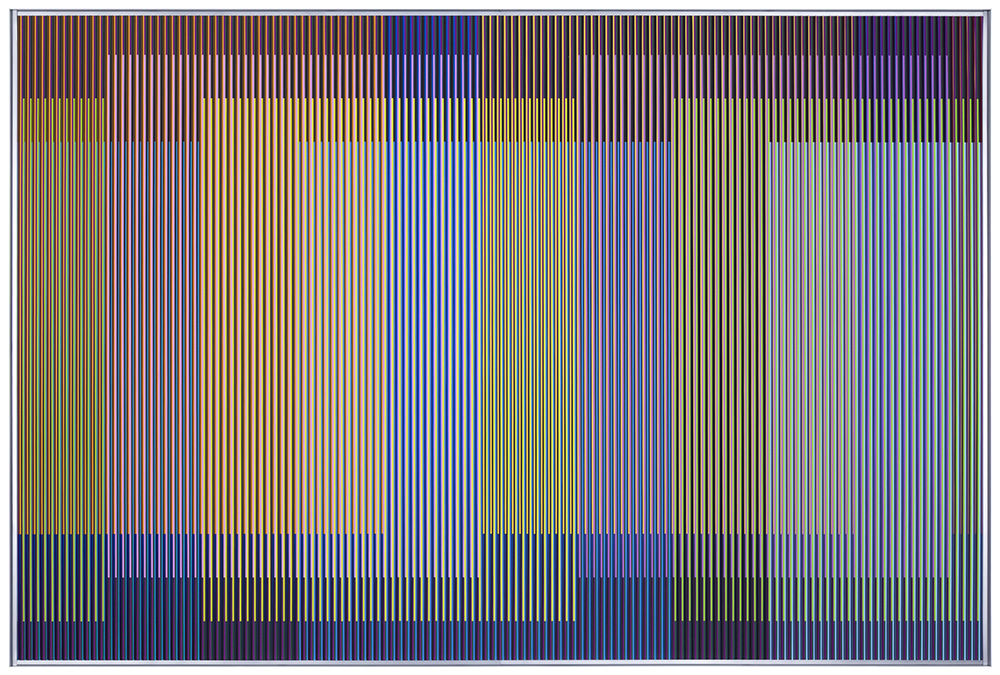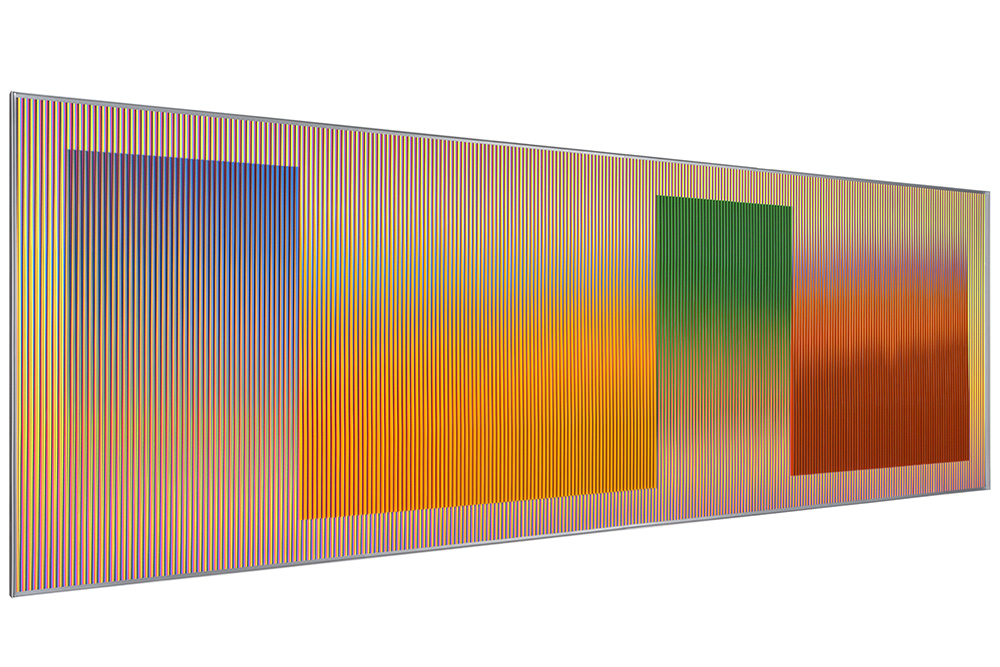ART CITIES: Brussels-Carlos Cruz Diez
 French-Venezuelan artist Carlos Cruz-Diez (1923 – 2019), is a major protagonist in the field of Kinetic and Optical Art, a movement that encourages “an awareness of the instability of reality”, his body of work established him as one of the key 20th century thinkers in the realm of color.Carlos Cruz-Diez’s visual art explores the perception of color as an autonomous reality evolving in space and time, unaided by form or support, in a perpetual present.
French-Venezuelan artist Carlos Cruz-Diez (1923 – 2019), is a major protagonist in the field of Kinetic and Optical Art, a movement that encourages “an awareness of the instability of reality”, his body of work established him as one of the key 20th century thinkers in the realm of color.Carlos Cruz-Diez’s visual art explores the perception of color as an autonomous reality evolving in space and time, unaided by form or support, in a perpetual present.
By Efi Michalarou
Photo: La Patinoire Royale Archive
The exhibition “Inter Lineas”, with works by Carlos Cruz-Diez immerses the viewer in a monumental “Chromointerferent Environment”. The objective of the “Chromointerferent Environments” is to create a situation in space involving the dematerialization, transfiguration, and ambiguity of color through movement. The constant movement of the projection makes people and objects seem transparent and, in this virtual state, they change shape and become “actors” in the experience and “authors” of a chromatic event that evolves in real time and space. Carlos Cruz-Diez spent his life as a passionate painter and enjoyed a very colorful life. Born in Caracas, Venezuela in 1923, as a boy he loved drawing in class, playing at his father’s desk with his rubber stamp and observing the world around him. At age 17 Cruz-Diez decided he wanted to be an artist and enrolled at the School of Fine Art, Caracas. Always the first student to arrive in the morning, he was ecstatic. In order to finance his studies he drew comics and after graduating worked in graphic design and as an illustrator, whilst developing his painting. As an academic painter Cruz-Diez was very successful but the more he studied art history the more he understood he wasn’t inventing art. He wanted to change his path and chose the relatively unexplored path of color as his focus. Cruz-Diez started to form his discourse and headed to Europe in 1955; first to El Masnou near Barcelona from which he travelled often to Paris, the place to be for artists and intellectuals. In Paris he was happy to discover that his thinking was in line with a lot of progressive artists from different countries. This group was creating a tendency that Victor Vasarely called the kinetic art movement. Cruz-Diez then briefly returned to Caracas thinking he could have more of an impact than in Europe where everything seemed to have already been done, but it was during his first exhibition in 1959 at the Fine Arts Museum of Caracas that he realized it was time to leave his country for good. People then just didn’t understand his art. In August 1960 Cruz-Diez took his family and headed for Paris, the epicentre of kinetic art. Cruz-Diez continued making a living as a graphic designer, all the while experimenting further with what he had already identified in Caracas the previous year. 1961 signalled his arrival to the European stage when he took part in “Bewogen Beweging”, the first major exhibition on kinetic art, at the Stedelijk Museum in Amsterdam. This was followed in 1964 by “Mouvement 2” at Galerie Denise René in Paris and then in 1965 by ‘The Responsive Eye’ at the Museum of Modern Art in New York. Soon he was in demand right across Europe, part of a group of artists changing art from something static into something that people could participate in. His first solo exhibition in Paris was at the Galerie Kerchache in 1965. To best manage his increasing work demands and ensure he could act on all the ideas in his head Cruz-Diez developed a way of accelerating his work rate by inventing tools to help him realize each artwork. First shedding academic painting, Cruz-Diez then embarked on a period of intense study where he read a great deal on art history. He identified that to find something new – even the tiniest gap – he would have to conduct meticulous research, much like a scientist, using a methodical approach. The works of color theorists, scientists like Chevreul, literary figures like Goethe, artists like Albers, Vasarely and Velasquez and the Impressionism movement informed his thinking. Eventually Cruz-Diez came to the realization that color had never been the subject of any artistic discourse. Always dismissed as a mere consequence of form, it spurred him on to further study the eye, perception of color and the way light changes. Gradually Cruz-Diez developed his discourse; that of color in space, devoid of form. His canvas’ reflect the ever-changing, ephemeral and mobile nature of color unlike the work of the Impressionists, which showcased the changing color of light but only in a motionless way that was in the past, not the present. He uses lines because it is the most efficient tool, devoid of symbolism and leaving only color without anecdote. Therefore color becomes a matter of personal preference, which is an emotional connection. Viewers connect with the color and through this find a poetry in his work. Over time Cruz-Diez developed his medium of showcasing color using the latest technology – always referring to the same principles – but demonstrated using increasingly accurate methods. At the age of 80 he began using the computer as a tool to further his investigations. His research continues to this day. Cruz-Diez was not only an innovator but an inventor. He was always creating, always looking for new solutions to better represent his research on color, and constantly inventing tools, and reimagining existing tools for his own purposes. Cutting-edge technology allowed him to create things he conceived of in the 1960s but couldn’t build at the time. Over a period of almost seven decades of research, refinement and discovery, Cruz-Diez never strayed from his original discourse. He remained amazed with life, passionate about his work and with a childlike enthusiasm that was utterly contagious. His ateliers in Paris, Caracas and Panama are testament to his philosophy of encouraging alternative ways of thinking and gave him the extra pairs of hands he needed to handcraft his vision at a prolific rate, that always lagged behind that of his imagination.
Photo: Carlos Cruz-Diez, artwork from the exhibition “Inter Lineas”, La Patinoire Royale – Galerie Valérie Bach-Brussels, 2021, © Atelier Cruz-Diez
Info: La Patinoire Royale – Galerie Valérie Bach, Rue Veydt, 15, Saint-Gilles, Bruxelles, Belgium, Duration: 18/11/2021-8/1/2022, Days & Hours: Tue-Wed 14:00-18:00, Thu-sat 11:00-19:00, www.prvbgallery.com








